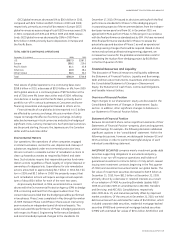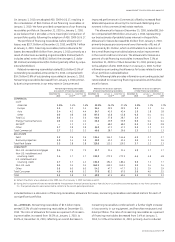GE 2010 Annual Report Download - page 55
Download and view the complete annual report
Please find page 55 of the 2010 GE annual report below. You can navigate through the pages in the report by either clicking on the pages listed below, or by using the keyword search tool below to find specific information within the annual report.management’s discussion and analsis
GE 2010 ANNUAL REPORT 53
OTHER GECS RECEIVABLES totaled $14.3 billion at December 31,
2010, and $18.6 billion at December 31, 2009, and consisted
primarily of amounts due from GE (primarily related to material
procurement programs of $2.7 billion and $2.5 billion at
December 31, 2010 and 2009, respectively), insurance receiv-
ables, nonfinancing customer receivables, amounts due under
operating leases, amounts accrued from investment income
and various sundry items. Amounts due from qualified special
purpose entities (QSPEs) declined from $3.7 billion in 2009
to $0.1 billion in 2010 as a result of our adoption of
ASU 2009-16 & 17.
PROPERTY, PLANT AND EQUIPMENT totaled $66.2 billion at
December 31, 2010, down $2.8 billion from 2009, primarily
reflecting a reduction in equipment leased to others and the
deconsolidation of Regency by GECS. GE property, plant and
equipment consisted of investments for its own productive use,
whereas the largest element for GECS was equipment provided
to third parties on operating leases. Details by category of
investment are presented in Note 7.
GE additions to property, plant and equipment totaled $2.4 bil-
lion in both 2010 and 2009, respectively. Total expenditures,
excluding equipment leased to others, for the past five years were
$13.5 billion, of which 40% was investment for growth through
new capacity and product development; 25% was investment in
productivity through new equipment and process improvements;
and 35% was investment for other purposes such as improve-
ment of research and development facilities and safety and
environmental protection.
GECS additions to property, plant and equipment were
$7.7 billion and $6.4 billion during 2010 and 2009, respectively,
primarily reflecting acquisitions and additions of commercial
aircraft at GECAS, offset by disposals of fleet vehicles at CLL.
GOODWILL AND OTHER INTANGIBLE ASSETS totaled $64.5 billion
and $10.0 billion, respectively, at December 31, 2010. Goodwill
decreased $0.6 billion from 2009, primarily from the deconsoli-
dation of Regency and the strengthening of the U.S. dollar,
partially offset by the acquisition of Clarient, Inc. Other intan-
gible assets decreased $1.8 billion from 2009, primarily from
dispositions and amortization expense. See Note 8.
ALL OTHER ASSETS comprise mainly real estate equity properties
and investments, equity and cost method investments, contract
costs and estimated earnings, derivative instruments and assets
held for sale, and totaled $96.3 billion at December 31, 2010, a
decrease of $6.9 billion, primarily related to declines in our real
estate equity properties due to impairments, depreciation and
the strengthening of the U.S. dollar. During 2010, we recognized
other-than-temporary impairments of cost and equity method
investments, excluding those related to real estate, of $0.1 billion.
Included in other assets are Real Estate equity investments of
$27.2 billion and $32.2 billion at December 31, 2010 and 2009,
respectively. Our portfolio is diversified, both geographically and
by asset type. We review the estimated values of our commercial
real estate investments semi-annually. As of our most recent
estimate performed in 2010, the carrying value of our Real Estate
investments exceeded their estimated value by approximately
$5.1 billion. The estimated value of the portfolio continues to
reflect deterioration in real estate values and market fundamen-
tals, including reduced market occupancy rates and market rents
as well as the effects of limited real estate market liquidity. Given
the current and expected challenging market conditions, there
continues to be risk and uncertainty surrounding commercial real
estate values. Declines in estimated value of real estate below
carrying amount result in impairment losses when the aggregate
undiscounted cash flow estimates used in the estimated value
measurement are below the carrying amount. As such, estimated
losses in the portfolio will not necessarily result in recognized
impairment losses. During 2010, Real Estate recognized pre-tax
impairments of $2.3 billion in its real estate held for investment,
compared with $0.8 billion in 2009. Real Estate investments with
undiscounted cash flows in excess of carrying value of 0% to 5%
at December 31, 2010 had a carrying value of $1.8 billion and an
associated unrealized loss of approximately $0.4 billion. Contin-
ued deterioration in economic conditions or prolonged market
illiquidity may result in further impairments being recognized.
Contract costs and estimated earnings reflect revenues
earned in excess of billings on our long-term contracts to con-
struct technically complex equipment (such as power generation,
aircraft engines and aeroderivative units) and long-term product
maintenance or extended warranty arrangements. Our total
contract costs and estimated earnings balances at December 31,
2010 and 2009, were $8.1 billion and $7.7 billion, respectively,
reflecting the timing of billing in relation to work performed, as
well as changes in estimates of future revenues and costs. Our total
contract costs and estimated earnings balance at December 31,
2010, primarily related to customers in our Energy, Aviation and
Transportation businesses. Further information is provided in
the Critical Accounting Estimates section.
LIQUIDITY AND BORROWINGS
We maintain a strong focus on liquidity. At both GE and GECS we
manage our liquidity to help ensure access to sufficient funding
at acceptable costs to meet our business needs and financial
obligations throughout business cycles.
Our liquidity and borrowing plans for GE and GECS are estab-
lished within the context of our annual financial and strategic
planning processes. At GE, our liquidity and funding plans take
into account the liquidity necessary to fund our operating com-
mitments, which include primarily purchase obligations for
inventory and equipment, payroll and general expenses. We also
take into account our capital allocation and growth objectives,
including paying dividends, repurchasing shares, investing in
research and development and acquiring industrial businesses.
At GE, we rely primarily on cash generated through our operating
activities and also have historically maintained a commercial
paper program that we regularly use to fund operations in the
U.S., principally within fiscal quarters.
























